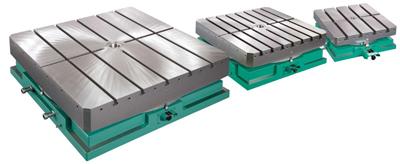
The "MBT" series of manual indexing tables from Indexing Technologies Inc. incorporate a precision Hirth coupling (face gear) for optimal positioning accuracy, repeatability and rigidity. Offered with either 360 teeth for 1° indexing or 72 teeth for 5° spacing, all within a radial accuracy of +/-2 seconds of arc.
Available in 10 different frame sizes, with tables ranging from 18" to 118" square or rectangular, all prepared with precision "T" slots ~ alignment slots, plus a center "pilot" bore for rapid and precise fixture locating.
The "MBT" series of pneumatic Manual Indexing Tables are completely self contained and are supplied with removable lifting bars which enable them to be easily moved on and off a machine or between different machines as needed.
With a load capacity of up to 50,000 lbs. there's a model suitable for most applications on horizontal boring mills, machining centers, milling and grinding machines, or grinding and gear cutting machinery.
*Note: Many users leave the piece part and fixture on the table and move the entire assembly through a variety of machines and operations to reduce valuable setup time.
Contact Details
Related Glossary Terms
- boring
boring
Enlarging a hole that already has been drilled or cored. Generally, it is an operation of truing the previously drilled hole with a single-point, lathe-type tool. Boring is essentially internal turning, in that usually a single-point cutting tool forms the internal shape. Some tools are available with two cutting edges to balance cutting forces.
- centers
centers
Cone-shaped pins that support a workpiece by one or two ends during machining. The centers fit into holes drilled in the workpiece ends. Centers that turn with the workpiece are called “live” centers; those that do not are called “dead” centers.
- fixture
fixture
Device, often made in-house, that holds a specific workpiece. See jig; modular fixturing.
- gang cutting ( milling)
gang cutting ( milling)
Machining with several cutters mounted on a single arbor, generally for simultaneous cutting.
- grinding
grinding
Machining operation in which material is removed from the workpiece by a powered abrasive wheel, stone, belt, paste, sheet, compound, slurry, etc. Takes various forms: surface grinding (creates flat and/or squared surfaces); cylindrical grinding (for external cylindrical and tapered shapes, fillets, undercuts, etc.); centerless grinding; chamfering; thread and form grinding; tool and cutter grinding; offhand grinding; lapping and polishing (grinding with extremely fine grits to create ultrasmooth surfaces); honing; and disc grinding.
- milling
milling
Machining operation in which metal or other material is removed by applying power to a rotating cutter. In vertical milling, the cutting tool is mounted vertically on the spindle. In horizontal milling, the cutting tool is mounted horizontally, either directly on the spindle or on an arbor. Horizontal milling is further broken down into conventional milling, where the cutter rotates opposite the direction of feed, or “up” into the workpiece; and climb milling, where the cutter rotates in the direction of feed, or “down” into the workpiece. Milling operations include plane or surface milling, endmilling, facemilling, angle milling, form milling and profiling.

